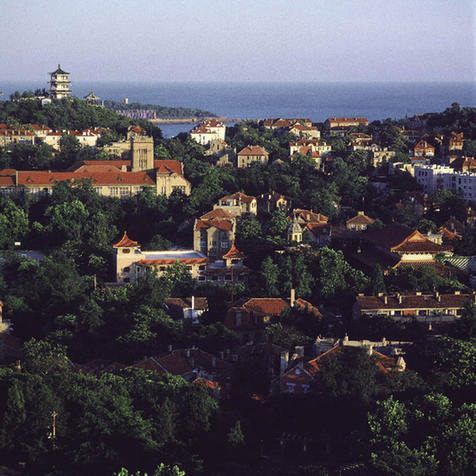China's Top Ten Seaside Cities
Qingdao, in the southeastern tip of the Shandong Peninsula, is as well known for its historical sites as for its beautiful seascape.
The Badaguan Scenic Area in the vicinity of No. 1 Bathing Beach has a cluster of European villas built in the early 20th century by aristocratic and royal families of more than 20 European countries at the invitation of German colonists who occupied Qingdao at the time. The villas sit quietly in the shade of green foliage that was introduced together with the foreign styled architechture, and are arranged into eight blocks, explaining its Chinese name.
Qingdao is a brewing hub, and the namesake local brew is known at home and abroad. Every August, domestic and international brands are consumed in the city, by locals and visitors who gather for the drinking festivals. The Qingdao Beer Festival is the largest of its kind in China. Locals love Qingdao beer, and they drink it, incredibly, from plastic bags, the ale fresh out of the brewery and cooler than chilled bottled beer.
|
 |
|
Achitecture from the period of the German colonialists still stands intact. |
Ningbo in Zhejiang Province lies 300 kilometers from Shanghai. The city is the birthplace of the 7,000-year-old Hemudu Culture, the starting point of the Marine Silk Road during the Tang Dynasty (618-907), and also one of the three foreign trade ports of that time (the other two being Yangzhou and Guangzhou). Ningbo is famed for its Buddhist heritage; the Asoka Temple houses the pearl-like cremated remains of Sakyamuni; Xuedou Mountain is a Buddhist center in Zhejiang and Jiangsu provinces; and the Baoguo Temple is the oldest wooden structure south of the Yangtze River.
Ningbo is also the cradle of Chinese merchants. Compared with their Wenzhou counterparts, Ningbo merchants are more inclined toward big endeavors, and one-fourth of Shanghai's shrewd business tycoons are said to be natives of Ningbo. Shipping magnate Bao Yugang (Sir Yue-kong Pao, 1918-1991) was an iconic Ningbo businessman. Ningbo is also an original hometown of many overseas Chinese; more than 300,000 people of Ningbo origin reside in more than 50 countries and regions around the world.
Xiamen in Fujian Province sits on the southeastern coast, and its Gulangyu Islet epitomizes the refined urban culture of the city. The 2-sq-km islet is separated from Xiamen by the 600-meter-wide Lujiang River, but can be reached by a five-minute ferry ride.
Gulangyu is nicknamed Piano Islet. There are more than 700 pianos for a local population of 20,000, averaging one for every ten families. Many of the families are dynastic pianists, and have produced some of the best pianists and musicians domestically and internationally, such as pianists Yin Chengzong and Kong Xiangdong, and conductor Chen Zuohuang. The municipal music school, concert hall, symphony orchestra and piano museum are located on this islet. On holidays, family piano concerts are often held, and it is not uncommon for three generations to play together.
New Holiday Resorts
Rizhao, Zhuhai and Beihai are latecomers compared with the aforementioned seaside resorts.
Rizhao is 800 kilometers from Beijing in the southern part of the Shandong Peninsula. In terms of commercial prosperity and service facilities, it pales beside its big brother Qingdao on the northern coast of the peninsula. However, it is a convenient getaway from urban bustle and has the same climate and beaches. When the traditional seaside resorts around Beijing become crowded, many Beijing urbanites go to Rizhao.
Rizhao also offers good prices for a seafood feast. Wangjiazao is a popular seafood catering community with many eateries to choose from. Locals too go there for seafood delicacies, as a meal averages a reasonable RMB 30 per person.
Zhuhai, on the southern coast of Guangdong Province, is close to Hong Kong and Macao. It is one of the earliest special economic zones in China, and, as a new seaside resort, is characterized by tranquility, cleanliness and fresh air. The city has an attractive long coastline, with 146 islets.
Marine hot springs are what's unique to Zhuhai. The Ocean Spring Resort, 30 kilometers from city proper, is currently the most frequented holiday destination of the city. According to the operator, the high-quality, crystal-clear spring originates deep in the sea, and is rich in minerals and trace elements.
Beihai is a small and relatively young city on the southern coast of Guangxi Zhuang Autonomous Region. Like Rizhao and Zhuhai, it is also a place for repose with fresh air and fine beaches. The best known is Silver Beach, though many outsiders prefer Weizhou Island, the largest island in Guangxi and the youngest volcanic island in China. Weizhou features beautiful tropical vegetation, fantastic lava terrain, and a wonderful land topography as a consequence of sea erosion and sedimentation. The sea is so clear that the sunlight pierces through and reveals the seabed. Weizhou has 16,000 residents, and interestingly, a third of them are Catholics.
Services
Economy
- Eco-agriculture and Eco-tourism Power Nanchang’s Green Development
- Balance Environmental Protection and Economic Prosperity – Nanchang Looks to European Technology for Green Development
- Sustainable Growth Requires Wiser Energy Use
- Chinese Economy: On the Path of Scientific Development
- China's Economy over the Last Ten Years

